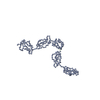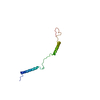[English] 日本語
 Yorodumi
Yorodumi- PDB-2qfg: Solution Structure of the N-terminal SCR-1/5 fragment of Compleme... -
+ Open data
Open data
- Basic information
Basic information
| Entry | Database: PDB / ID: 2qfg | ||||||
|---|---|---|---|---|---|---|---|
| Title | Solution Structure of the N-terminal SCR-1/5 fragment of Complement Factor H. | ||||||
 Components Components | Complement factor H | ||||||
 Keywords Keywords | IMMUNE SYSTEM / X-ray scattering / complement / SCR domain / Factor H / Age-related macular degeneration / Complement alternate pathway / Disease mutation / Glycoprotein / Immune response / Innate immunity / Sushi | ||||||
| Function / homology |  Function and homology information Function and homology informationregulation of complement activation, alternative pathway / symbiont cell surface / regulation of complement-dependent cytotoxicity / regulation of complement activation / complement component C3b binding / heparan sulfate proteoglycan binding / serine-type endopeptidase complex / complement activation / complement activation, alternative pathway / Regulation of Complement cascade ...regulation of complement activation, alternative pathway / symbiont cell surface / regulation of complement-dependent cytotoxicity / regulation of complement activation / complement component C3b binding / heparan sulfate proteoglycan binding / serine-type endopeptidase complex / complement activation / complement activation, alternative pathway / Regulation of Complement cascade / heparin binding / blood microparticle / proteolysis / extracellular space / extracellular exosome / extracellular region / identical protein binding Similarity search - Function | ||||||
| Biological species |  Homo sapiens (human) Homo sapiens (human) | ||||||
| Method |  SOLUTION SCATTERING SOLUTION SCATTERING | ||||||
 Authors Authors | Okemefuna, A.I. / Gilbert, H.E. / Griggs, K.M. / Ormsby, R.J. / Gordon, D.L. / Perkins, S.J. | ||||||
 Citation Citation |  Journal: J.Mol.Biol. / Year: 2008 Journal: J.Mol.Biol. / Year: 2008Title: The regulatory SCR-1/5 and cell surface-binding SCR-16/20 fragments of factor H reveal partially folded-back solution structures and different self-associative properties. Authors: Okemefuna, A.I. / Gilbert, H.E. / Griggs, K.M. / Ormsby, R.J. / Gordon, D.L. / Perkins, S.J. | ||||||
| History |
|
- Structure visualization
Structure visualization
| Structure viewer | Molecule:  Molmil Molmil Jmol/JSmol Jmol/JSmol |
|---|
- Downloads & links
Downloads & links
- Download
Download
| PDBx/mmCIF format |  2qfg.cif.gz 2qfg.cif.gz | 86.9 KB | Display |  PDBx/mmCIF format PDBx/mmCIF format |
|---|---|---|---|---|
| PDB format |  pdb2qfg.ent.gz pdb2qfg.ent.gz | 57.5 KB | Display |  PDB format PDB format |
| PDBx/mmJSON format |  2qfg.json.gz 2qfg.json.gz | Tree view |  PDBx/mmJSON format PDBx/mmJSON format | |
| Others |  Other downloads Other downloads |
-Validation report
| Summary document |  2qfg_validation.pdf.gz 2qfg_validation.pdf.gz | 320.5 KB | Display |  wwPDB validaton report wwPDB validaton report |
|---|---|---|---|---|
| Full document |  2qfg_full_validation.pdf.gz 2qfg_full_validation.pdf.gz | 324.5 KB | Display | |
| Data in XML |  2qfg_validation.xml.gz 2qfg_validation.xml.gz | 2.1 KB | Display | |
| Data in CIF |  2qfg_validation.cif.gz 2qfg_validation.cif.gz | 23.8 KB | Display | |
| Arichive directory |  https://data.pdbj.org/pub/pdb/validation_reports/qf/2qfg https://data.pdbj.org/pub/pdb/validation_reports/qf/2qfg ftp://data.pdbj.org/pub/pdb/validation_reports/qf/2qfg ftp://data.pdbj.org/pub/pdb/validation_reports/qf/2qfg | HTTPS FTP |
-Related structure data
- Links
Links
- Assembly
Assembly
| Deposited unit | 
|
|---|---|
| 1 |
|
| Number of models | 9 |
- Components
Components
| #1: Protein | Mass: 35434.668 Da / Num. of mol.: 1 / Fragment: SCR domains 1-5 (residues 19-322) Source method: isolated from a genetically manipulated source Source: (gene. exp.)  Homo sapiens (human) Homo sapiens (human)Description: Protein was purified by Nickel affinity and size exclusion chromatography. Gene: CFH, HF, HF1, HF2 / Production host:  Pichia pastoris (fungus) / Strain (production host): X33 / References: UniProt: P08603 Pichia pastoris (fungus) / Strain (production host): X33 / References: UniProt: P08603 |
|---|
-Experimental details
-Experiment
| Experiment | Method:  SOLUTION SCATTERING SOLUTION SCATTERING |
|---|
-Data collection
| Detector | Date: May 24, 2006 |
|---|---|
| Radiation | Monochromator: MIRROR / Protocol: SINGLE WAVELENGTH / Monochromatic (M) / Laue (L): M / Scattering type: x-ray |
| Radiation wavelength | Relative weight: 1 |
| Soln scatter | Type: x-ray Buffer name: 137 MM NACL 2.5 MM KCL 8.1 MM NA2HPO4 1.5 MM KH2PO4 Conc. range: 0.21-0.84 / Data analysis software list: SCTPL7, GNOM / Data reduction software list: MULTICCD / Detector type: FRELON CCD CAMERA / Mean guiner radius: 4.26 nm / Mean guiner radius esd: 0.16 nm / Min mean cross sectional radii gyration: 1.46 nm / Min mean cross sectional radii gyration esd: 0.08 nm / Num. of time frames: 10 / Protein length: 1 / Sample pH: 7.3 / Source beamline: IDO2 / Source class: Y / Source type: ESRF GRENOBLE / Temperature: 296 K |
- Processing
Processing
| Software |
| ||||||||||||||||||
|---|---|---|---|---|---|---|---|---|---|---|---|---|---|---|---|---|---|---|---|
| Refinement step | Cycle: LAST
| ||||||||||||||||||
| Soln scatter model | Details: TWELVE SOLUTION STRUCTURES ARE DEPOSITED. THE FIRST OF THESE CORRESPONDS TO THE BEST-FIT STRUCTURE IN THE PRIMARY CITATION, WHILE THE OTHER ELEVEN CORRESPOND TO THOSE ADDITIONALLY SHOWN IN ...Details: TWELVE SOLUTION STRUCTURES ARE DEPOSITED. THE FIRST OF THESE CORRESPONDS TO THE BEST-FIT STRUCTURE IN THE PRIMARY CITATION, WHILE THE OTHER ELEVEN CORRESPOND TO THOSE ADDITIONALLY SHOWN IN FIGURE 11(A) OF THE PRIMARY CITATION Num. of conformers submitted: 12 / Representative conformer: 1 / Software list: INSIGHT II, SCTPL7, GNOM |
 Movie
Movie Controller
Controller










 PDBj
PDBj

